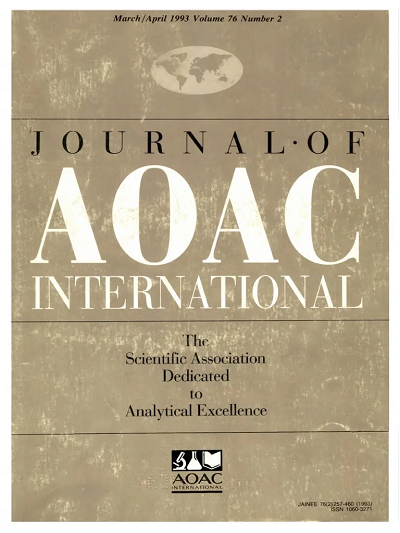元素分析手册》第 4.7 方法对六种新增元素钴 (Co)、锶 (Sr)、铊 (Tl)、锡 (Sn)、铀 (U) 和钒 (V) 的分析物扩展方法验证
IF 1.7
4区 农林科学
Q3 CHEMISTRY, ANALYTICAL
引用次数: 0
摘要
背景 美国食品和药物管理局(FDA)东北食品和饲料实验室(NFFL)以及食品安全和应用营养中心(CFSAN)开展了一项实验室间研究,目的是扩展 FDA 元素分析手册(EAM)方法 4.7(使用微波辅助消化法,电感耦合等离子体-质谱法测定食品中的砷、镉、铬、铅、汞和其他元素),以纳入新的分析物(1)。这项研究的目的是证明 FDA EAM 方法 4.7 在分析新的分析物钴(Co)、锶(Sr)、铊 (Tl)、锡(Sn)、铀(U)和钒(V)时的性能。对 EAM 4.7 进行的钴 (Co)、锶 (Sr)、铊 (Tl)、锡 (Sn)、铀 (U) 和钒 (V) 六种新增元素的分析物扩展方法验证,遵循了二级或单一实验室验证的所有准则,并符合《化学方法验证准则》(3) 规定的分析物扩展的所有验收标准。方法 根据 EAM 4.7 (1),本研究遵循了相关程序,并使用了在建议条件下运行的指定设备。分析物扩展方法验证是按照规程进行的,没有任何偏差。结果 从分析数据来看,EAM 4.7 中关于被分析物扩展方法验证的所有质量控制 (QC) 要求均已通过。通过对方法空白、基质尖峰、未强化测试样品和参考材料的成功分析,结果表明了准确度、线性度和精密度。分析数据符合所有代表性基质中每种分析物的验证要求。结论 研究表明,使用 EAM 4.7 对食品进行总酸性可萃取元素分析时,新分析物的性能令人满意,符合 FDA 的指导原则 (3)。亮点 该方法达到或超过了性能标准。本文章由计算机程序翻译,如有差异,请以英文原文为准。
Analyte Extension Method Validation of Elemental Analysis Manual Method 4.7 for Six Additional Elements, Cobalt (Co), Strontium (Sr), Thallium (Tl), Tin (Sn), Uranium (U) and Vanadium (V)
Background An interlaboratory study was conducted at the U.S. Food and Drug Administration’s (FDA) Northeast Food and Feed Laboratory (NFFL) and the Center for Food Safety and Applied Nutrition (CFSAN) with the purpose to expand FDA Elemental Analysis Manual (EAM) method 4.7 (Inductively Coupled Plasma-Mass Spectrometric Determination of Arsenic, Cadmium, Chromium, Lead, Mercury, and Other Elements in Food Using Microwave Assisted Digestion) to include new analytes (1). Objective The goal of the study was to demonstrate the performance of FDA EAM method 4.7 when analyzing new analytes cobalt (Co), strontium (Sr), thallium (Tl), tin (Sn), uranium (U) and vanadium (V). This analyte extension method validation of EAM 4.7 for six additional elements, Co, Sr, Tl, Sn, U and V followed all guidelines for a Level 2 or single laboratory validation and met all acceptance criteria for analyte extensions as per the Guidelines for the Validation of Chemical Methods (3). Method As per EAM 4.7 (1), this study followed the procedures and used specified equipment operated under recommended conditions. The analyte extension method validation was performed per protocol and with no deviations. Results All quality control (QC) requirements for this analyte extension method validation of EAM 4.7 passed as evidenced by the analytical data. The results presented demonstrate accuracy, linearity and precision by successful analyses of method blanks, matrix spikes, unfortified test samples and reference materials. The data analyzed met each of the validation requirements for each analyte in all representative matrices. Conclusion The study showed that the new analytes performed satisfactorily using EAM 4.7 for total acidic extractable elemental analysis of food according to FDA’s guidelines (3). Highlights The method met or exceeded the performance criteria.
求助全文
通过发布文献求助,成功后即可免费获取论文全文。
去求助
来源期刊

Journal of AOAC International
医学-分析化学
CiteScore
3.10
自引率
12.50%
发文量
144
审稿时长
2.7 months
期刊介绍:
The Journal of AOAC INTERNATIONAL publishes the latest in basic and applied research in analytical sciences related to foods, drugs, agriculture, the environment, and more. The Journal is the method researchers'' forum for exchanging information and keeping informed of new technology and techniques pertinent to regulatory agencies and regulated industries.
 求助内容:
求助内容: 应助结果提醒方式:
应助结果提醒方式:


